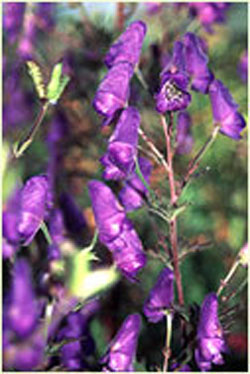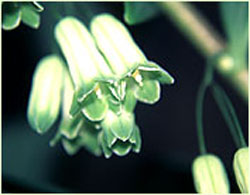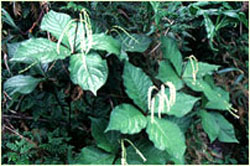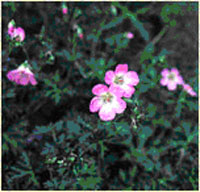Is it all Plastic in Taiwan?
Plant Collecting in Taiwan in the nineties
by
Bleddyn Wynn-Jones
Bleddyn Wynn-Jones runs a specialist nursery with his wife Sue, close to the North Wales coast on the same site that they previously farmed for nearly 20 years. They opened t he nursery in 1991 while starting their annual seed collecting expeditions. These were to Asia in the early years progressing to the Americas in more recent times, covering over 20 different countries and making many thousands of introductions to cultivation.
 Stauntonia purpurea
Stauntonia purpurea
Taiwan – that is a strange destination to search for garden plants, "Surely there can be nothing that is hardy from such a country, straddling the Tropic of Cancer,' we were told. Tropical or not, on investigating firstly the Flora of Taiwan we were encouraged to dig deeper. Many plants familiar to us from our gardens were there :- Aconitum, Actinidia, Adenophora, Akebia, Ampelopsis, Anemone, Arisaema, Aristolochia, Artemisia and Asarum... all that remained was for us to seek them out. This we did near the end of October in 1992, the first of several trips to this botanical oasis. Despite the reputation it now has for having wall-to-wall industry, it is of little surprise to us that the island was for many years known by its Latin name of Formosa, meaning beautiful.
By now we had built up a good working relationship with several academic and practical institutes on the island, which bore fruit on both sides of the association. Hence by mid- summer of 1996, when the call to the wild became irresistible, we decided to postpone our itinerary from collecting in Korea and Japan. We felt that we were lacking plants in some of our previous collections from Taiwan, particularly in those genera which had become more important to the development of our nursery.
On the morning of September the 18th the two of us found ourselves jet- lagged, bleary eyed and weary in the middle of a Taiwanese jungle. We had organised our nursery to be tucked away for the winter during the twelve weeks of our absence by our very capable team of helpers, affectionately known as 'The Staff'.
The first sight was chosen as we had found an all-sterile flowered form of Hydrangea kawakamii (H. aspera kawakamii) back in December 1993. Drawn to small tree-like proportions in the forests, here on the edge they make a more manageable garden-sized large shrub. The sturdy cymes of bright-purple fertile flowers are surrounded by pale sepalled sterile flowers of butterfly-like elegance. This late summer flowering shrub is still rare in the British garden, soon to be rectified by some of the forms we are now finding. The felty, smooth haired leaves on some of these are colossal, of dinner-plate proportions, with comparative inflorescences to 60cm across. It was our main quest on this trip, to trace the differing species and forms as described by the British guru of Hydrangeas, Michael Haworth-Booth, and which are now lumped into just a few species.
The disappointment of there being no sterile sports on the bush was soon forgotten with each new collection. This area near Chilan in northern Taiwan, is easily the richest and most diverse in Taiwan, which means that it comes close to being the richest source of temperate plants remaining in the world. There are still new plants being discovered in this area, Arisaema ilanensis was the most recent to have been described. This is yet another superlative plant quite different to any Arisaema we have encountered in cultivation, with an almost horizontally protruding spadix out of a glaucous deep-purple spathe, below the dark green waxy digitate leaves.
Bright red fruit of Schisandra arisanensis were to be found here in abundance hanging in long drupes from the overhanging trees and shrubs: a valuable deciduous, twining climber with orange-red male flowers and yellow-orange female flowers. These are borne in clusters from the leaf axils from April to June, contrasting with the glossy dark green pointed leaves.
Akebia longeracemosa was to be found here clothing some of the taller trees. This species has elegant, digitate, five-leafleted long and narrow evergreen leaves. These are accompanied by long pendant racemes of purple flowers, to 15cm in Spring. The few larger female flowers occupy the upper region of these racemes, while the plentiful males below make up the mass of the inflorescence. When pollinated the female flowers produce a purple sausage shaped edible fruit. These have rarely been seen on these Taiwanese species according to our botanical colleagues, who had never found any. This time we were in luck and managed to find a few ripe fruit before the monkeys did.
It was in this area that we found Stauntonia purpurea, of a smaller habit, seldom seen to twine above five metres after scrambling off the forest floor. A close relative to Akebia, with its leathery Schefflera-like, evergreen, undulating digitate leaves. In the form we have these are complemented by short racemes of fragrant, pendant, pixie hat-like bright purple flowers in spring. These are followed by a plump sausage-like edible fruit in the autumn, as do many of the members of the under-utilised Lardizabalaceae family. Again our early arrival had paid off and we had beaten the rivalling monkeys to this rarely found fruit.The forest floor also had its rewards, amongst the plants that we are now more familiar with, like Tricyrtis formosana, Rohdea watanabei, Podophyllum pleianthum, Arisaema taiwanensis, Disporopsis arisanensis etc. We were able to find Polygonatum alte-lobatum, Asarum taipingshanianum, Phytolacca japonica and Paris bockiana – all useful additions to our gardens, as Arisaema thunbergii var. autumnalis may be, one day. Although we had found this species back in 1993 (photo The Garden May 1994 p209) we were unaware of its identity until 1995 when it was described to science. It is a peculiar Arisaema in that it is induced into flower by the cooling of the autumn, a little earlier than the more familiar A. ringens, whose inflorescence erupts from the ground in early December, where we find it growing at a much lower altitude near the eastern coast. Surprisingly this plant adapts readily to our European gardens by emerging in the spring.
The most dramatic of our Arisaema introductions to date must be A. taiwanensis. Usually standing erect to about a metre tall, one is immediately drawn even in its early stages of growth by the strong, decoratively mottled stems, opening its single leaf as it does, like an umbrella of broad radiating leaflets. These in turn support long dangling thread-like tips, sometimes nearly reaching the ground. The familiar shaped sinister looking purple spathe (housing the inflorescence) also supports a long filiform tip at its extremity, which in turn overhangs the spongy apex of the spadix.
The Paris bockiana we found in this area can be only be found at the higher altitudes in the central and eastern parts of the island. It grows in light forest conditions to 30cm tall, with four to seven narrow leaflets held in a single whirl slightly below the 'green' flower. This has evolved to possess only narrow petals, yellowish in this species, with broader green sepals supporting the central reproductive parts. As with the rest of the Daiswa section of Paris, the centre of the flower matures to a large green ribbed fruit. This in turn splits open when ripe to reveal the bright red fleshy seed.
 Aconitum fukutomeia v.formosanum
Aconitum fukutomeia v.formosanum
Aconitum fukutomei (syn A. bartlettii is an unusual monkshood growing on the forest edge:. Our first encounter with this variety was Aconitum fukutomei v. formosanum. This is a considerably different plant from the normal. A. fukutomei (syn A. bartlettii) that we had encountered on the high slopes of the Central Mountains, where the plants were short and bright blue flowered. Here the flowers were almost purple in colour, while the stems were anything but short, twining loosely into the hosting shrubs up to a couple of metres.
Overshadowing these were Viburnum luzonicum v oblongum and V. taiwanianum both weighted down by their abundant red fruit at this time of the year. Also feeling the strain of an abundant crop of fruit was the winter flowering Stachyurus himalaicus (yellow flowering in Taiwan), reminding us of the previous year's contrastingly arduous trip to Nepal.
Hydrangea paniculata is also to be found in Northern Taiwan, where we found some outstanding forms which we hope to secure in cultivation. Many of the shrubs were weighted down with their heavy crops of blooms, others reached a lofty height of some five metres, jostling for space amongst Daphniphyllum glaucescens ssp. oldhamii – a splendid glaucous subspecies of this aristocratic genus. Staying with our quest we also secured material of Pileostegia viburnoides from the Taipingshan area, an evergreen aerial rooting climber. The form from this area looked quite different from that which we are used to seeing in cultivation: it will be interesting to monitor its progress before we introduce this collection into cultivation.
An unusual member of the Campanulaceae family is also found here growing at the forest edges: we also find it on fairly open mountainsides. Codonopsis kawakamii with its dangling yellowish waisted bells, twining on anything that is within reach to 1.5 metres. We went nearby in search of another newly described plan, Dianthus palinensis, bearing the largest flowers of the genus in Taiwan. We were under strict instructions from our propagator, David Chandler, to collect every Dianthus or Silene we could lay our hands on. So, with the threat of mass destruction looming over our plants back home, off we went to the village of Pa-lin. If we were in desperate need to find a plant for ourselves it would have taken for ever to find it – if we could have found it at all. It took us just half an hour, if that, to locate its ripe capsules brimming with seed, perched on sunny ledges on a roadside cliff. Is it not the way of the world?
We were however rewarded en route by a demure member of the Lily family. Heloniopsis umbellata could be found growing on vertical walls of deep moist (or is it always raining when we find it?) moss. This small evergreen rosette-forming perennial is invaluable for colonising the woodland garden, forming tiny plantlets where the leaf tips are in contact with the ground. A central winter resting bud stretches out in spring to a single sided scape of white flowers. These flared, scented flowers age to a pale pink and are followed by green capsules which disgorge their thread-like seed, to be dispersed by the slightest breeze.
At this time of the year the star turn in the forest was reserved for the Clematis. There were several, and one in particular presented a heady scent. It was of a modest size, growing mostly to only five metres, but covered by outward-facing, pure white, wide-open flowers crammed with long white stamens. The name for this charming species is C. parviloba subsp bartlettii. Here we also found a solitary plant of a rich yellow, pendant flowering Clematis, scrambling its way through the undergrowth. On later presenting this specimen to Dr Aleck Yang at the Museum in Taichung for identification, we were immediately informed that it was a new species to Taiwan, later to be confirmed as being new to science. He has since named this Clematis szuyuanensis.
He was also able to identify for us Clematis that we had previously collected in Taiwan and had only been able to distribute under our collection numbers. C. tashiroi we were told was what we had collected as BSWJ1423. It was unusual with its deep purple petals and a large boss of contrasting white stamen, coming into flower in August. It is probably only suitable for outdoor cultivation in the milder areas of this country, being evergreen, despite having shrugged off -11C with us. C. henryi var. morii was the identification given to BSWJ1668, a white scented, pendant winter flowering evergreen trifoliate species we had collected in 1993. Our third evergreen collection of that same year was C. uncinata BSWJ1893, white flowering with long narrow ridged leaves.
Our next destination was the dramatic Taroko Gorge with its spectacular scenery. The solid marble sides at the bottom section are sheer to almost 2,000 meters in places.It is hardly surprising that the Chinese regard it as one of the natural wonders of the World. Here is where we found Silene fortunei in both pink and white forms. At a higher altitude we encountered – for the first time for us – Hydrangea longifolia, a closely related species to the better known H. involucrata which we had encountered previously in neighbouring Japan. Hydrangea longifolia differs mainly in its much narrower and longer foliage, in the larger sterile sepals and in the deeper coloured cymes of fertile flowers.
In the upper part of this area we had already collected H. integrifolia, back in 1992, an evergreen, aerial-rooting climber which now scrambles up our ysgubor wall at home. The name is often confused with H. integerrima which is the old name for the South American H. serratifolia. H. integrifolia is the only evergreen climbing Hydrangea to be found in the 'Old World' according to Elizabeth McClintock's revision of this genus.
Also from here, we have secured material of Hydrangea angustipetala. We had been impressed by the size of both the sepals and of the terminal cymes of yellow ageing flowers, which we had encountered in the various herbariums in Taiwan. On this trip we also managed to track down several vastly differing forms of Hydrangea chinensis, with its more leathery leaves. It is closely related to the preceding species, these we encountered tucked away in the forests in all four corners of the island.
Taroko is where we also came upon one of the most stately of all the Solomon Seals, Polygonatum cyrtonema (Hua), reaching a lofty two metres when grown with some moisture.
 Polygonatum cyrtonema
Polygonatum cyrtonema
Returning to the family of Hydrangeaceae, we had collected in 1992 material of Schizophragma integrifolium v. fauriei from this area. It is found scrambling along the forest floors before it finds a small tree or cliff to climb: it celebrates on finding the sun by exploding into a generous display of 25cm wide terminal corymbs margined by sterile flowers. It is distinguished from the standard form of this aerial rooting, climbing species by its hairy foliage which is a perfect foil for the single-sided, 5cm showy ovate sepals. Again we now have a plant on our outbuildings, which has shot up to five metres within three growing seasons despite two cold winters, even holding its foliage at -11C throughout that winter. Maybe this will be the year our patience will be rewarded by the sight of its first flowering.
The sixth species of Hydrangea to be found in Taiwan is H. anomala. We collected this at a tropical latitude, but at high elevation, again, it was scrambling on the forest floor looking for a host to climb. Strange to find it isolated geographically from the rest of H. anomala, but that is Taiwan, a rich isolated diversity of nature, a jewel set in the ocean. This is the area we had previously collected Cimicifuga simplex, a first time we believe, a Cimicifuga has;been found in the Tropics. The material we collected has since been studied by James Compton of Reading University, who has now re-classified it as a new species, Cimicifuga taiwanensis. This was before he amalgamated the whole genus of Cimicifuga into Actaea (which will I am certain, please many a reader). Mixed with this we also found a couple of favourites amongst our customers, firstly Smilacina formosana, which is now contented enough in our garden to reward us by self-seeding. In the same vein as the Polygonatum cyrtonema, it is a stately plant with its reddish-brown, robust, arching stems of bold alternating leaves. It is crowned in spring with a large plume of heavily scented Lily-of-the-Valley-like panicles of white flowers, followed through the summer by a generous crop of red fruit. The second of these was Arisaema formosana forma stenophyllum, distinct in this form, with its leaves consisting of seven to fifteen very narrow (from less than a centimetre wide) radiating leaflets on sometimes tall stems.
Often found literally at their feet is a diminutive member of the bramble clan. Rubus pectinellus var. trilobus, an evergreen for sheltered shade, with the most unusual foliage patterned with silver and black, enhancing this nodal rooting prostrate grower. It is a welcomed alternative to Ivy as ground covering in shade, rewarding us with the occasional white flower and red fruit.
 Chloranthus oldhamii
Chloranthus oldhamii
Common in this central area is Chloranthus oldhamii from a barely cultivated genus in the West, but long appreciated by the subtler Japanese horticulturist. With us this perennial remains evergreen, holding its shallowly toothed leaves in two opposite pairs on stems up to 50cm long. The flowers are highly scented while not being particularly showy: this is more than makes up for by the extraordinary length of time that they are held.
The final member of the Hydrangea family to elude our grasp was, Cardiandra formosana, a herbaceous plant. After many a fruitless search, we finally tracked this down to Hsitou Experimental Forestry Reserve.This was a clammy, moist area, where the Cardiandras were to be found growing in light to deep shade on steep banks and walls, appearing like moths fluttering in the gloomy shade. This should complement the late summer garden, where some moisture can be provided in the growing season, rewarding us with purple lace-cap cymes of fertile flowers accompanied by their moth-like sterile sepals. Finding this plant had been particularly difficult for us, demanding all the energy we could muster at the end of a long and demanding trip in 1993. On our final attempt of our last morning in the field, a last ditch effort was rewarded by success – a high note to finish on.
It was not the only prize to be found here, Asarum hypogynum, endemic to this small area, could be found cheek-by-jowl with the Cardiandra. A formidable species of this ever more popular genus, distinct amongst the Taiwanese species by its much larger leaf and flower. They are closely related to Aristolochia the climbing Dutchman's Pipe. Some leaves we see are almost 30cm long, patterned with a pewtery-white overlay in the best forms.
Geranium was a familiar name near the top of our "shopping list'' for Taiwan. Most, as elsewhere in the world, are quite weedy, but there were two that were worthy of seeking out. G. suzukii is a pleasant low creeping species found in the shade of the higher elevated forest. It is reminiscent of G. procurrens in its habit of rooting at the leaf nodes, but much more restrained by its compactness. The small, dark green, rounded leaves of this species colour-up nicely when exposed to some sunlight, setting off the pure white flowers even more effectively.
 Geranium hayatanum
Geranium hayatanum
A second species, G. hayatanum, that we found on the mountain tops has proved to be very hardy and garden-worthy. It emerges, in some forms, with yellow red-rimmed mottled foliage in spring, before producing a continuous supply of good-sized pink flowers into the autumn. It is found growing mostly intertwined with dwarf bamboos and Coriaria intermedia, the former covering the high mountains like grass. This plant remains fairly compact at 40 cm. in the garden when given good light and is now amongst our most popular Geraniums. The Coriaria now also attracts many favourable comments in our garden, with its dangling tassels of tiny red flowers in spring followed by arching branches of fern-like foliage, later complemented with an abundance of red fruit.
The choice of plants as I mentioned earlier is awesome, we have by now collected some two thousand plants from Taiwan, most of which have not previously been tried in our gardens. We advise you to keep a sharp look-out in the future for more garden-worthy Taiwanese plants on the horticultural trail and to remember that not everything that emerges from Taiwan is made of plastic.
© 2006 Bleddyn Wynn-Jones www.crug-farm.co.uk
